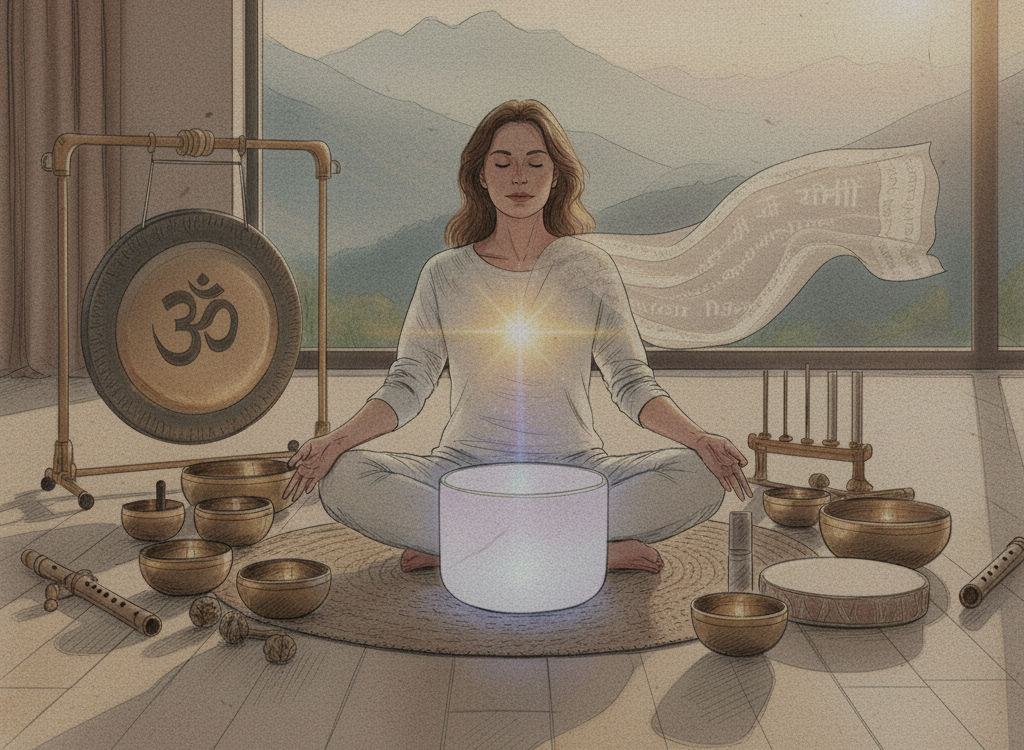Bridging Ancient Vibration with Modern Wellness
Sound healing has seen a dramatic rise in popularity in recent years. From meditation apps using binaural beats to therapists integrating crystal bowls and tuning forks into sessions, the world is rediscovering the power of sound as medicine. But beneath this modern resurgence lies an ancient system that has long understood the transformational nature of sound: Nada Yoga.
Nada Yoga, often referred to as the Yoga of Sound, offers a profound philosophical and experiential framework that directly informs today’s most effective sound healing practices. In this post, we explore how the ancient wisdom of Nada Yoga lives on in the tools, techniques, and therapeutic principles used by modern sound healers around the world.
What is Nada Yoga? The Subtle Science of Sound
In Sanskrit, nada means “sound” or more precisely, “vibration.” Nada Yoga is the yogic path that uses sound—both internal and external—as a medium to reach heightened states of consciousness.
It is based on the understanding that everything in the universe is in a state of vibration, and that by tuning into these vibrations, we can access the source of life and consciousness itself.
Nada Yoga divides sound into two key categories:
- Ahata Nada: External, struck sound — what we hear through the ears (e.g., music, mantras, instruments).
- Anahata Nada: Internal, unstruck sound — the subtle vibration perceived in deep states of meditation (often associated with the Anahata or heart chakra).
This system is not merely theoretical; it is a practice-oriented approach where sound becomes both the vehicle and the destination on the spiritual path.
How Nada Yoga Connects to Modern Sound Healing
The parallels between Nada Yoga and modern vibrational therapy are striking. While modern methods may use scientific language and digital instruments, the core principles remain deeply aligned with yogic sound healing.
Mantras and Brainwaves
Nada Yoga uses Sanskrit mantras to shift consciousness, similar to how binaural beats or Solfeggio frequencies are used to influence brainwave states today.
Sound as Medicine
Nada Yoga views sound as a healing force that works through resonance, much like today’s therapeutic tools such as tuning forks or gongs.
Holistic Integration
Both systems recognize that sound affects not only the mind but also the body, emotions, and energy field. The vibrational frequencies we absorb can recalibrate our nervous system, restore emotional balance, and align the subtle body.
Timeless Techniques from Nada Yoga Still Used Today
Many of the most effective sound healing techniques in use today are directly adapted from traditional Nada Yoga practices. These include:
1. Mantra Repetition (Japa Yoga)
Chanting sacred syllables like Om, So Hum, or Gayatri builds vibrational coherence and supports emotional healing.
2. Listening Meditation (Nada Anusandhana)
A deep, receptive practice of listening — often to the tanpura or the subtle inner sound — enhances awareness, calms the mind, and opens access to meditative states.
3. Breath and Sound Fusion
Integrating pranayama with vocalized tones links breath with vibration, creating energetic alignment.
4. Instrument-Based Sound Immersion
Nada Yoga makes use of traditional Indian instruments like the tanpura, flute, and singing bowls, whose harmonic overtones create a sonic field of healing resonance.
Scientific Validation of Nada Yoga Principles
Modern neuroscience and bioacoustics are beginning to validate what yogis have known for centuries.
- Mantra repetition has been shown to reduce activity in the default mode network (DMN), associated with stress and rumination.
- Sound frequencies can entrain brainwaves, shifting the mind from beta (alert) to alpha or theta (meditative) states.
- Stimulation of the vagus nerve through chanting or humming activates the parasympathetic nervous system, inducing calm and emotional balance.
These findings offer scientific grounding to the age-old practices of Nada Yoga and open up new avenues for its integration in clinical settings.
Integrating Nada Yoga into Your Sound Healing Practice
Whether you’re a sound healer, yoga teacher, or therapist, incorporating Nada Yoga principles can elevate your sessions to a more authentic and energetically aligned level.
Here’s how to begin:
- Differentiate between outer and inner sound: Guide clients to listen both externally (Ahata) and internally (Anahata) during sessions.
- Use Sanskrit mantras with clear intention, not just for ambiance but for their energetic signatures.
- Blend ancient instruments with modern tools, creating layered experiences that connect deep-rooted tradition with accessible formats.
By grounding your sound work in Nada Yoga, you offer clients more than just relaxation—you provide transformation through vibrational awareness.
Student Insight: The Power of Nada Yoga at Our School
At Nada Yoga School in Rishikesh, students consistently report profound shifts in their perception and healing capacities after practicing Nada Yoga.
One graduate shares:
“Before I came, I had only experienced sound healing as a passive listener. Nada Yoga taught me how to generate and direct sound from within. That inner connection changed everything for me, both as a healer and a human being.”
Conclusion: A Timeless Science for Modern Healing
As the world rediscovers the healing power of sound, Nada Yoga stands as both origin and guide. It offers not just techniques, but a way of perceiving reality through vibration—a way that brings wholeness, presence, and profound healing.
If you’re ready to explore this deeper path, consider joining our immersive teacher training.
Ready to Learn More?
🔗 Join the Nada Yoga Teacher Training Program in Rishikesh
Experience the vibrational science of sound through the guidance of traditional masters, and become a certified sound healer rooted in authenticity.





